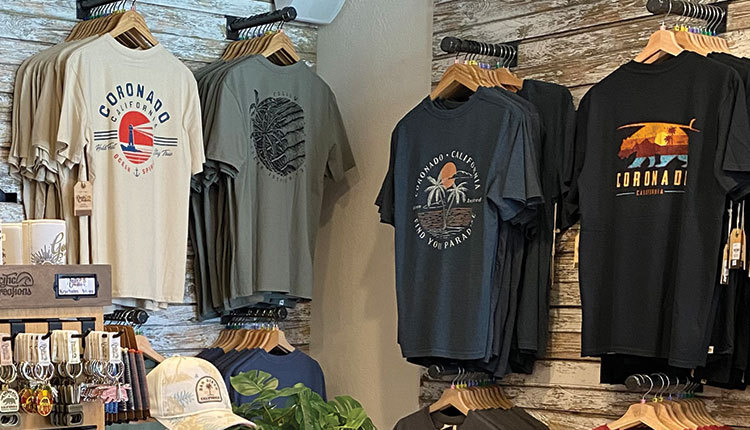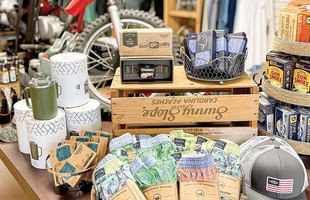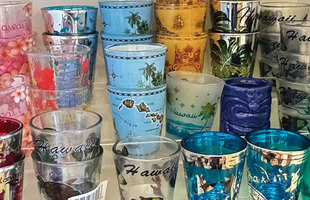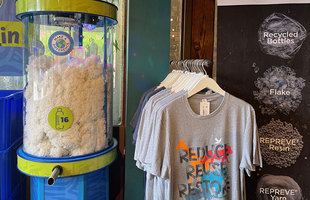Kelleys Island is a popular Ohio vacation destination in the warm summer months, with thousands of people taking a ferry to the Lake Erie island for day trips and vacation homes. For many years, Kelleys Island Clothing Company has been a go-to shop on the island for name-dropped apparel and souvenirs.
Carla Pelz has served as co-owner of the shop alongside her husband, Kevin, for the past six years. The couple also has run a wholesale T-shirt business called Pelz Lettering Shirt Shack for about three decades.
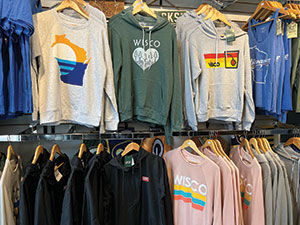
New wall racks help to highlight Urban Milwaukee’s top-selling sweatshirts.
One of their customers was the previous tenants of the Kelleys Island gift shop. The couple even helped the previous owners set up displays for apparel in the shop, and since becoming owners they rearranged apparel to improve visibility.
Today, customers are immediately drawn to the store’s vibrant name-dropped shirts displayed prominently along the two main walls of the store, held up on custom-made T-shirt towers. The store’s lighting also points to these displays, helping to draw attention to it. Customers can then easily find the shirts they want in cubbies underneath the tower displays.
Michael Hale, CEO of the Los Angeles-based Retail Rehab consultancy, explains that the purpose for apparel displays is to draw attention to top-selling merchandise, helping customers find what they are looking for.
“If you walk into a store and all you see are shirts on four-way racks, it helps to have one table with two bust forms to break that sea of monotony,” he explains. “I think the same goes for a T-shirt wall. If you have a 20-foot wall, break it up into sections.”
Hale adds that there’s no “magic number” when it comes to determining how many mannequins, bust forms or other apparel displays a destination retailer sets out, but he stresses, “Be sure you have enough.”
Know the numbers
How exactly can destination retailers be sure they “have enough” apparel displays in their stores? Hale notes that sales data can help retailers determine how much space to dedicate to each product category as well as how many displays to include for those products, including apparel.
“It’s really good to understand what your sales look like in a molecular way,” he explains. “Look at what do my men’s T-shirts sell? Ladies? Kids? It’s analysis.”
For instance, if apparel makes up 30% of a store’s business, Hale suggests it should occupy 30% of the store’s space, with displays to draw attention to those areas.
“It has nothing to do with what you think or feel — it’s based on numbers. That’s a strategic way of looking at it,” says Hale.
Early in her days as owner of Kelleys Island Clothing Company, Pelz says she was quickly surprised at how many sweatshirts people were buying in the middle of summer months.
“I used to not devote much space to sweatshirts. But it’s probably our second bestseller,” she notes. “I now devote more space to sweatshirts because it’s what people are asking for.”
Destination retailers also may be tempted to simply display apparel that looks pretty or is the most attractive on their bust forms, but Hale advises retailers use data rather than feelings to ultimately make that call. A store’s top sellers need to be on display rather than what the owner “feels” is best.
“I wouldn’t say there’s a general rule that a store should have XYZ with apparel, but it is important to listen to what your numbers tell you,” Hale says.
Just the right amount
One of the biggest mistakes Hale sees destination retailers make is having an over-assortment of apparel, whether it’s too many styles of a logoed T-shirt or too many color options of one shirt design.
“I would rather see fewer assortments, fewer colors and make sure you have the full size range,” he explains. “With too many choices, your open to buy might not allow you to spend as much money on each product, and you might sell out of certain sizes faster.”
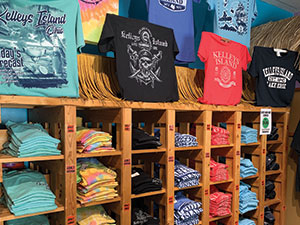
Kelleys Island Clothing Company uses T-shirt towers to show off its name-dropped shirts and organizes the shirts in cubbies underneath the displays.
In Coronado, California, Coronado Mercantile offers popular apparel brands along with some name-drop souvenirs. Store Manager and Buyer Rachel Hengst says she makes sure the store always appears well stocked, but not too full.
“You want to give them space to see all you have to offer without overlooking anything,” she explains.
Hengst says most of her store’s apparel lines include sizes XS to 3XL, with a few lines that offer 4XL.
“It’s nice to be size inclusive for whoever may walk through our doors,” she says.
Drawing attention to options for youth is also important. Pelz says she has one section of her store dedicated to youth T-shirts and hoodies.
“I have a gridwall with arms coming out with youth shirts, so you can look and see all the youth T-shirts at once,” she says. “I carry some shirts that come with markers so kids can color the shirt, and some with glitter for little girls over on a separate rack. But they’re all in the same area.”
Neat and organized
In addition to displaying apparel, Hale advises destination retailers to keep their apparel sections well-organized to increase the perceived value of the merchandise. He explains that people are more likely to buy a T-shirt if it’s hanging neatly on a rack rather than that same T-shirt poorly folded in a cubby.
“A customer’s perceived value of goods is based on how they’re presented,” he says. “Every display should elevate the value of the goods.”
Apparel has always been a top-selling category at Urban Milwaukee Inc., but Owner Dave Reid says he had the chance to reorganize and clean up his shop after a fire a few years ago.
“We had a fire during COVID and rebuilt the store and reopened,” he says. “It allowed us to buy new racks and keep more in a small space.”
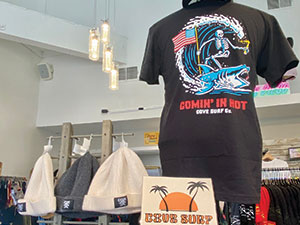
Coronado Mercantile displays T-shirts on its walls and uses bust forms to showcase what it has to offer in its apparel category.
Reid adds that the store previously used cubbies along the walls to showcase T-shirt options.
“The cubbies required a lot of extra work to keep the place looking good,” he says, noting that shirts regularly had to be refolded to look neat.
Since the fire, he transitioned to displaying T-shirts on slat wall and stocking shirts on several floor racks.
“Moving to the racks was a big improvement,” says Reid. “We can display more now and it allows us to have more product.”
Open to changes
How often a destination retailer changes its apparel displays depends in part on how big that category is for them as well as the number of recurring customers who shop at the store. At the very least, Hale suggests destination retailers change out apparel displays with every season.
“If you’re getting only first-time customers who are coming into town each season, then you may not need to change your displays a whole lot throughout the seasons,” he says. “But if you’re a store that serves your locals or you’ve got repeat customers that are coming back several times throughout the season, you’re going to want to update those displays so that your customers don’t see it as stale.”
Reid shares that he usually changes his store’s two mannequins with each season, unless he notices he needs to make a change mid-season to showcase a trending T-shirt style. He’ll also make a change mid-season if the store is starting to run low on a style that’s being displayed.
Destination retailers also shouldn’t be afraid to change displays that aren’t working. Hengst loves setting up displays at Coronado Mercantile — she suspects her background in making theater displays helps her with this task. She notes that she makes sure not to get too attached to any display at the shop.
“Like in theater, you work hard on a show set and then tear it down,” she says. “Even if I think a display looks great, the layout is great, it may not be working to move the product. I have to decide that it doesn’t work and try something else.”
No matter how often a destination retailer changes their apparel displays, they need to make sure they always stand out. Pelz notes that Kelleys Island Clothing Company’s T-shirt towers are perhaps the most noticeable displays in her store.
“You have to make it eye-catching,” she says of apparel displays.
Indeed, eye-catching apparel displays can help destination retailers to boost their apparel sales.
